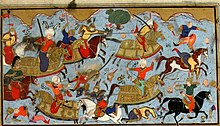Battle of Çıldır
| Battle of Çıldır | |||||||||
|---|---|---|---|---|---|---|---|---|---|
| Part of the Ottoman–Safavid War (1578–1590) | |||||||||
 Depiction of a battle in the Ottoman Empire | |||||||||
| |||||||||
| Belligerents | |||||||||
| Ottoman Empire | |||||||||
| Commanders and leaders | |||||||||
|
Lala Mustafa Pasha Özdemiroğlu Osman Pasha Sinan Pasha | Tokhmaq Khan Ustajlu | ||||||||
| Strength | |||||||||
| Unknown |
25,000 Persians 7,000 Georgians | ||||||||
| Casualties and losses | |||||||||
| Unknown |
5,000–7,000 killed in action[2] 3,000 executed[2] | ||||||||
The Battle of Çıldır was fought in 1578 during the Ottoman–Safavid War (1578–1590).
Background
[edit]The peace between the Ottoman Empire and Persian (Safavid) Empire after the treaty of Amasya continued from 1555 to 1578. When Murat III of the Ottoman Empire ascended to the throne in 1574, Tahmasp I of Persia sent presents to Murat III. But before the Persian delegation left Istanbul, the Ottoman capital, Tahmasp died (1576). The new shah was Ismail II who changed the peaceful policy towards Ottomans and began hostilities in the border area. Meanwhile, the governor of Lorestan, a part of Persia, took refuge in Ottoman lands, an event which further created tension between the two empires. İsmail II soon died and during the interregnum following his death, the Ottoman Porte decided to declare war.[3] The war continued during the reign of Mohammed Khodabanda in Persia.
Battle
[edit]After initial combat in so-called Cambaz Çukuru,[3] the main battle was around a small fort named Çıldır in north-eastern Anatolia. The commander of the Ottoman army was Lala Mustafa Pasha and the commander of the Persian army was Mohammad Khan Tokhmaq Ustajlu who had represented Persia in Istanbul after Murad III's accession. Tokhmak Khan also had a Georgian army under his command, Georgia being a Persian vassal (and its royal families being related by marriage). Tokhmak Khan tried to encircle the Ottoman army and was about to succeed when Ottoman commander Özdemiroğlu Osman Pasha intervened and defeated him.[4]
Aftermath
[edit]Although Persians tried to attack Ottoman supply units after the battle, they were forced to retreat and when a bridge was wrecked during this retreat they lost further troops. These defeats left the Caucasus to Ottoman conquest. Lala Mustafa Pasha soon conquered Tiflis, the Georgian capital.[5] The next step was the conquest of Derbent (present Republic of Dagestan in Russia). By this conquest Ottomans were able to reach the Caspian Sea.
See also
[edit]- Lala Mustafa Pasha's Caucasian campaign
- Battle of Torches
- Treaty of Istanbul (1590)
- Ottoman–Persian Wars
References
[edit]- ^ Jackson, Peter and Laurence Lockhart, The Cambridge History of Iran: The Timur and Safavid Periods, Vol.6, (Cambridge University Press, 1986), 257.
- ^ a b Matthee 2014, p. 18.
- ^ a b Prof. Yaşar Yüce-Prof. Ali Sevim: Türkiye tarihi Cilt III, AKDTYKTTK Yayınları, Istanbul, 1991 p. 21
- ^ Nicolae Jorga: Geschichte des Osmanischen vol III (trans:Nilüfer Epçeli) Yeditepe yayınevi, Istanbul, ISBN 975-6480-20-3,p. 207
- ^ Joseph von Hammer: Osmanlı Tarihi Vol II (condensation: Abdülkadir Karahan), Milliyet yayınları, Istanbul. p. 96
Sources
[edit]- Matthee, Rudi (2014). "The Ottoman-Safavid War of 986-998/1578-90: Motives and Causes". In Karpat, Kemal; Balgamış, Deniz (eds.). International Journal of Turkish Studies. Vol. 20, Nos 1& 2.
